From Conor O'Brien's
"Sea-Boats, Oars and Sails"
<> Gaff Rig Ideas <>
It's well worth finding this little book. O'Brien was a
cruising yachtsman who sailed around the world - he also ran in one
Fastnet Race with his yacht, which was rigged with a square sail. He
didn't win, but apparently he had an interesting time. In the book he
diagrams how to rig a small boat three or four ways, using the same
hull and the same sail area, keeping everything reasonably small and
low. Here are a few examples. I've omitted his Standing Lug and
Spritsail drawings as they aren't anything out of the ordinary.
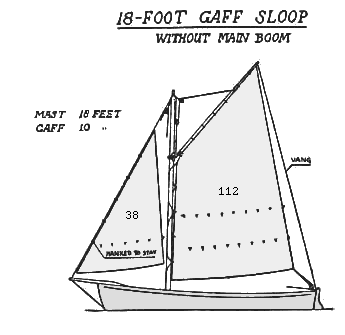
Now of course you don't need to re-rig your boat, but these
ideas are simple, cheap, and based on his seagoing and Channel-cruising
experience, meaner stuff than we're likely to encounter with our
day-cruisers.
Note the vang on the gaffer. Vangs died out sometime in the
1800s and are all but unknown to yachties but in old paintings and
drawings vangs are used all the time on spritsail rigs and gaff rigs;
the vang controls the end of the gaff and helps prevent sagging in
going to windward. It also controls the gaff when running before the
wind.
In his days gaffs were heavy. On a small boat, or in a more
modern mode, we can consider using bamboo, aluminum tubing, or some
sort of carbon fiber. I keep wondering about scrapped carbon fiber
windsurfer masts as yards or gaffs.
Conor also hated booms. I think we can probably use both a
boom and his rigging ideas. I'd consider, at least, experimenting with
a light boom and battens at the reef points if I went to rig a boat
following his advice. But that's another topic.
•••
Gaff or Yard
A removable sail. The peak tie loops over a groove at the end of the
spar and through a hole. The halyard passes through its own end and
sits between wooden chocks (this could also be a block of wood with a
hole in it; a comb-cleat). His diagram shows the anti-jamming "forth
and back" lacing on the mast.
The small diagram shows lacing the head of the sail to
the boom with individual loops of line.
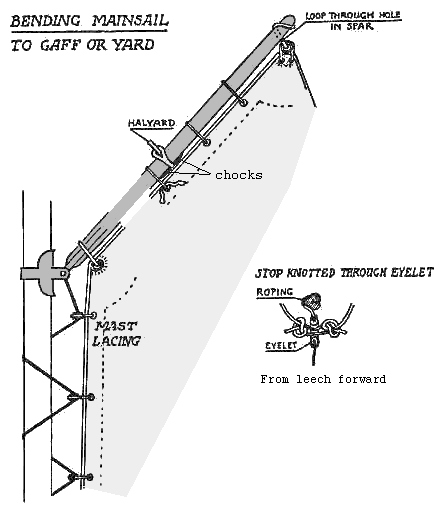
|
Halyard
"It is curious that none of the examples
which survive in England -- bawleys, Itchen ferry boats (probably
extinct), Plymouth hookers, and their like, take advantage of vangs to
make the sails set on a wind, and that they all use two halyards where
one will do. The 30-foot gaff of the Norfolk wherry, which has to be
cleared away and got up again when the mast is lowered for shooting
bridges, is hoisted with a single halyard; so is the smaller gaff of
the whaleboat used in the Azores. In the Norfolk rig, as simplified for
a 10-foot gaff (Fig. IVa), the halyard leads through a masthead block
down to a single block on the gaff jaws, up to another masthead block,
and is made fast to the peak; since there is a two-to-one purchase on
the throat and none on the peak, the luff of the sail is stretched
before the peak is set up."
I use this arrangement on a lug sail yard and it works
very well at keeping the yard at the proper angle, and firmly in place.
It was written up long ago by George Holmes in connection with
lug-rigged canoe yawls but Conor is writing with reference to
'wherries', gaff riggers which sailed on the Norfolk Broads in England.
He was writing in the 1930s so the line from the lower block he calls
wire rope. We can use Spectra line or prestretch Dacron.
|
|
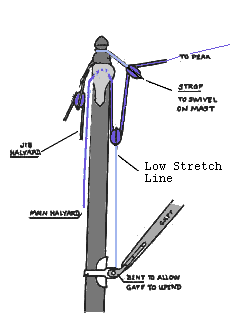
|
Halyard
|
|
Want a topsail?
Try this.
"I said it was probably easiest to lower the
mainsail right down to reef it ; let us try lowering it right down to
set a topsail over it.
"The topsail is bent to a yard the whole length of
its luff, and the heel of the yard hooked to an eye on one side of the
gaff jaws, and a rope becket on the clew of the sail slipped over the
peak of the gaff. The yard can hang from this while the mainsail is
being hoisted, then it is straightened up by the halyard, which is the
only extra rope aloft. Lowering would be easy if the topsail were to
leeward of the peak halyards, for it would fall down into the lee of
the mainsail ; not quite so easy if to windward, and it might be
desirable to have a line bent to the yard to haul it down on its proper
side of the gaff. This rig has the merit that the lightest part of it
is on top, and the biggest topsail can be very large and light indeed."
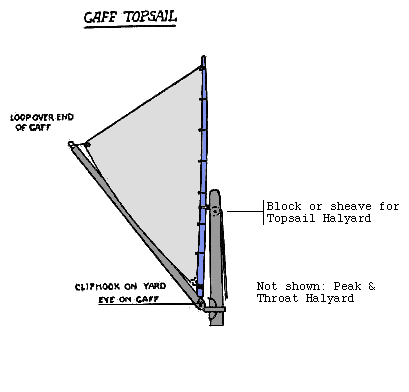
He admits he hasn't actually tried it, but as he says,
there's no reason it won't work on a small boat. The topsail halyard is
a long line which stays rigged through its sheave.
If you add an extended yard to the bottom of the
topsail to make it stick out beyond the gaff, you'd have a "jackyard
topsail". No reason this same scheme would not work for such a topsail.
Now the vang on the end of the gaff becomes a topsail
sheet. Hmmm. Clever.
|
Gunter
Sprit Rig
Ah, his "favorite rig". This he calls the "gunter sprit" but it's
practically identical to the "pound-net sharpie" sail described in
Chapelle's American Small Sailing Craft. Again the "vang" or
"mast rope" is essentially an upper sheet. O'Brien doesn't like booms,
but these rigs work fine with booms. If you add battens along the reef
points you wind up with something very much like Commodore Munroe's
sharpie sail plans.
The "sprit" is rigidly attached to the jaws so it
won't foul the mizzen mast, and the upper leech keeps it at the same
angle when the gunter yard is hoisted. The gunter yard could swivel on
the jaws so that stowing the sail becomes a simple matter when the rig
is off the boat.
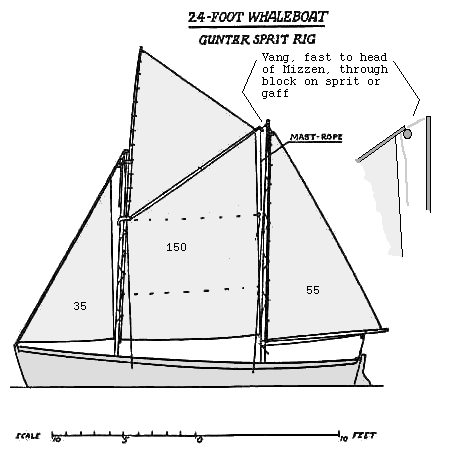 "Since the sprit always makes the same angle with the mast the end of
it may come within an inch of the mizzen mast and still never touch it,
whatever height it is hoisted to ; therefore it completely fills the
space between the masts, which a gaff sail cannot do. A rope is made
fast to the mizzen masthead, rove through a thimble [block, or fairlead
-- COD] on the end of the sprit, and belayed at the foot of that mast ;
the sprit, sliding up or down this mast-rope, is under control all the
time ; it is in fact the main sheet, for it takes most of the weight
off the clew of the sail.
"Since the sprit always makes the same angle with the mast the end of
it may come within an inch of the mizzen mast and still never touch it,
whatever height it is hoisted to ; therefore it completely fills the
space between the masts, which a gaff sail cannot do. A rope is made
fast to the mizzen masthead, rove through a thimble [block, or fairlead
-- COD] on the end of the sprit, and belayed at the foot of that mast ;
the sprit, sliding up or down this mast-rope, is under control all the
time ; it is in fact the main sheet, for it takes most of the weight
off the clew of the sail.
"I have tried out the principle on my twenty-ton
yacht, not indeed with a gunter sprit, which I am only recommending
from personal experience as a boat's sail, but with a gaff and topsail
of just the same shape ; and I found trimming sail absurdly easy. With
a single-part mast-rope I could pull the gaff flat amidships when a
yachtsman's gale was blowing, and a single whip on the clew was ample
for the lower sheet. The peculiar advantage of the gunter sprit is that
in reefing you have only the halyards to look after, the rest looks
after itself. When the heel of the sprit is right down on the thwart
there is only about 6 feet of the leach of the sail loose, as I have
drawn it, and less than 30 square feet of sail area ; the weakest man
could hardly fail to get hold of the close reef cringle and secure it,
and I should keep a lazy sheet made fast to that cringle to make it
easy to catch."
|
•••
Three knots
...of those he thinks you should know. The Stunsail bend makes the
smallest glob of line at the spar of any knot, he says, so it won't
hold the yard away from the sheave or block. The Topsail Sheet bend is
something fun to know. I just like the drawing of the anchor.
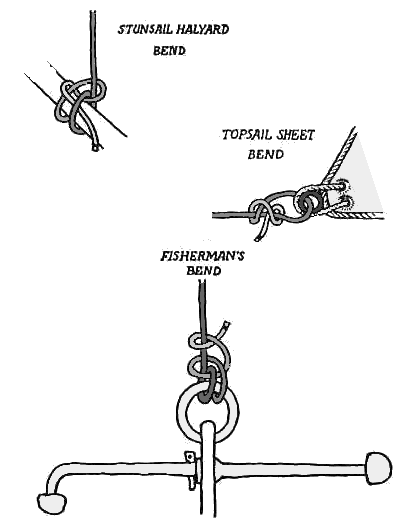
Top •• back to Odd Sails
|





